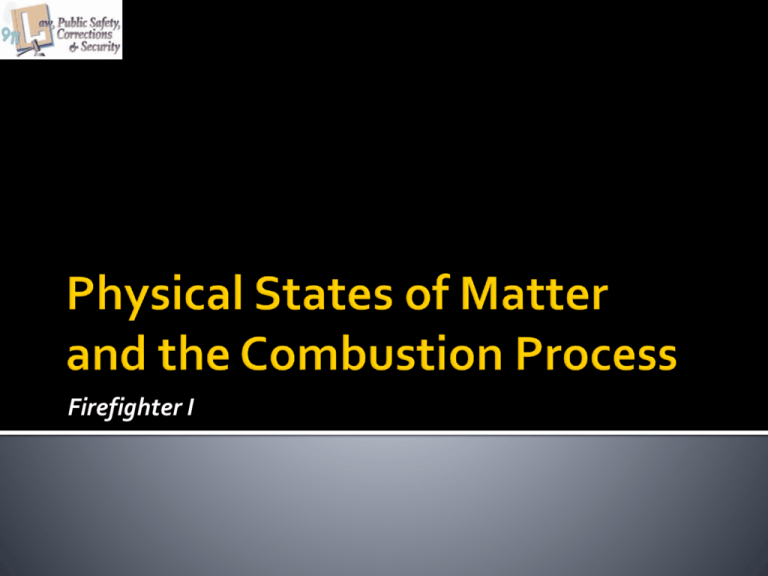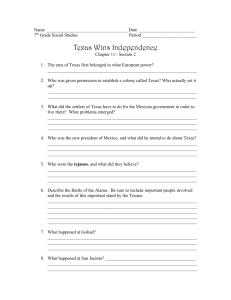
Firefighter I
Copyright and Terms of Service
Copyright © Texas Education Agency, 2011. These materials are copyrighted © and trademarked ™ as
the property of the Texas Education Agency (TEA) and may not be reproduced without the express
written permission of TEA, except under the following conditions:
1) Texas public school districts, charter schools, and Education Service Centers may reproduce and use
copies of the Materials and Related Materials for the districts’ and schools’ educational use without
obtaining permission from TEA.
2) Residents of the state of Texas may reproduce and use copies of the Materials and Related Materials
for individual personal use only, without obtaining written permission of TEA.
3) Any portion reproduced must be reproduced in its entirety and remain unedited, unaltered and
unchanged in any way.
4) No monetary charge can be made for the reproduced materials or any document containing them;
however, a reasonable charge to cover only the cost of reproduction and distribution may be
charged.
Private entities or persons located in Texas that are not Texas public school districts, Texas Education
Service Centers, or Texas charter schools or any entity, whether public or private, educational or noneducational, located outside the state of Texas MUST obtain written approval from TEA and will be
required to enter into a license agreement that may involve the payment of a licensing fee or a royalty.
Contact TEA Copyrights with any questions you may have.
Copyright © Texas Education Agency 2011. All rights reserved.
Images and other multimedia content used with permission.
2
The weight of a given volume of vapor or
gas, compared to an equal volume of dry
air at an equal vapor pressure
All vapors and gases mix with air
The vapor density of air is 1
Copyright © Texas Education Agency 2011. All rights reserved.
Images and other multimedia content used with permission.
3
The vapor density of air is 1
Gases with vapor density
Less than air, rise and dissipate
Greater than air, sink and accumulate
Copyright © Texas Education Agency 2011. All rights reserved.
Images and other multimedia content used with permission.
4
Some common
flammable gases
Copyright © Texas Education Agency 2011. All rights reserved.
Images and other multimedia content used with permission.
5
The weight of a substance
compared to the weight of an
equal volume of water at an equal
temperature
Copyright © Texas Education Agency 2011. All rights reserved.
Images and other multimedia content used with permission.
6
Substances with a specific
gravity
Lighter than water, float
Heavier than water, sink
Copyright © Texas Education Agency 2011. All rights reserved.
Images and other multimedia content used with permission.
7
Water and most flammable and combustible
liquids don’t mix with each other (immiscible).
Hazardous because the flammable fuels will float
on the water where they could ignite or burn
Important when considering firefighting tactics
and strategies and the limits placed on
extinguishment options
Copyright © Texas Education Agency 2011. All rights reserved.
Images and other multimedia content used with permission.
8
Flammable liquids burning on top of water in a
tanker spill that occurred in 1991.
Copyright © Texas Education Agency 2011. All rights reserved.
Images and other multimedia content used with permission.
9
The surface area of a fuel in
proportion to its mass
The higher the surface-tomass ratio of a fuel, the
higher its ignitability
Copyright © Texas Education Agency 2011. All rights reserved.
Images and other multimedia content used with permission.
10
A piece of plywood on
its edge exposes 3
surface areas
Orientation of a fuel
matters!
Copyright © Texas Education Agency 2011. All rights reserved.
Images and other multimedia content used with permission.
11
Affected by surface-tomass ratio
Depends on fuel type, fuel
quantity, and the
orientation of the fuel
Increases as more fuel
becomes involved in the
combustion process
Copyright © Texas Education Agency 2011. All rights reserved.
Images and other multimedia content used with permission.
12
Most fire-related deaths
are caused by smoke
Smoke is made of gases,
vapor, and soot (solid
particulates) that are
inherently poisonous
Regard all smoke as toxic
and hazardous
Copyright © Texas Education Agency 2011. All rights reserved.
Images and other multimedia content used with permission.
13
Carbon monoxide (CO)
Hydrogen cyanide (HCN)
Carbon dioxide (CO2)
Irritants
Particulates
Copyright © Texas Education Agency 2011. All rights reserved.
Images and other multimedia content used with permission.
14
A byproduct of the incomplete combustion of fuels
containing carbon
The most common product of combustion found at
structure fires
The leading cause of civilian fire deaths
A chemical asphyxiate that binds with hemoglobin,
inhibiting oxygen transfer
Copyright © Texas Education Agency 2011. All rights reserved.
Images and other multimedia content used with permission.
15
A byproduct of combustible
fuels containing nitrogen
A chemical asphyxiate that
prevents the body from
using oxygen at the cellular
level
Most associated with the
combustion of polyurethane
foam, which is commonly
found or used in furniture
and bedding
Copyright © Texas Education Agency 2011. All rights reserved.
Images and other multimedia content used with permission.
16
A byproduct of complete combustion
Not considered to be toxic, but it can act as
an asphyxiate by displacing oxygen
Also acts as a respiratory stimulant by
increasing the respiratory rate of its victims
Copyright © Texas Education Agency 2011. All rights reserved.
Images and other multimedia content used with permission.
17
Byproducts of combustion that
can
Make breathing difficult and
uncomfortable
Inflame the eyes, respiratory
tract, and skin
Smoke can carry different and
varied irritants, depending on
the fuel source
Copyright © Texas Education Agency 2011. All rights reserved.
Images and other multimedia content used with permission.
18
Byproducts that can be inhaled
and deposited in the mouth,
trachea, and lungs
May cause respiratory distress
and irritation to the eyes
There may be additional
health hazards specific to the
fuels being burned
Copyright © Texas Education Agency 2011. All rights reserved.
Images and other multimedia content used with permission.
19
0135151112, Essentials of Firefighting (5th
Edition), International Fire Service Training
Association (IFSTA)
Images used with permission by IFSTA.
Copyright © Texas Education Agency 2011. All rights reserved.
Images and other multimedia content used with permission.
20








